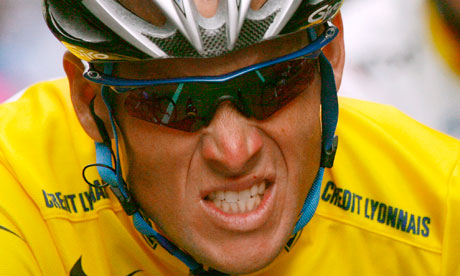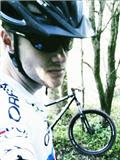Lance Armstrong, World Champion, 7 time Tour de France Winner and Cancer survivor. To many he is iconic not just to the sport of cycling but to those who have ever suffered or been effected by cancer.
His book 'It's not about the bike' is a detailed true story of his fight and survival against a cancer that brought him close to death and his return to the forefront of cycling's premium race the Tour de France from 1999 onwards. His seven wins from 1999 to 2005 were often magnificent his domination of a the tour a splendour to watch and to many of his fans he is a hero. But with great success also comes equal suspicion, his victories tainted with accusation of illegal doping and blood transfusions. It seems that no one is allowed to be this good without being suspected of being a cheat.

Recently the American Anti doping Committee (USADA) led by Travis Trygart have submitted evidence against Lance that he prohibited substances, had trafficked drugs including EPO and testosterone, and had administered such drugs to others. USADA also have evidence that Armstrong assisted, encouraged, aided, abetted and covered up those anti doping violations. This evidence also includes Johann Bruyneel the director sportif, RadioShacks team doctor Pedro Celaya and Pepi Marti the team trainer for the last decade.
All to often forum sites and Lance Armstrong's fan base have failed to understand the above. All to often he is excused because he passed over 500 drugs tests from urine and blood taken at any time in and out of competition, and that USADA can't strip him of his titles as he has not officially been caught.
Lets look at this as a defence for him. Firstly this isn't just about doping to win in races but also how he has been involved with doping in the sport. There are ten of his team mates who are willing to testify that he was involved. Now to Lance he feels that these people have been bribed with money or pardons to cover for their own usages of drugs within the sport. Some this could well be the case but if people like George Hincapie who has continued to ride 17 tours and has been one of Lances right hand men or even described as a 'brother', is willing to speak out then eyebrows should be raised. Others over the years have also proved not only their own evidence his involvement but his attitude towards doping:
Lance has often been quick to legally bring down anyone who would blacken his name, these include Emma O'Reilly, US Postals Team Massuese who testified against Lance. O'Reilly said she heard team officials worrying about Armstrong's positive test for steroids during the Tour. She said: "They were in a panic, saying: 'What are we going to do? What are we going to do?' "
Their solution was to get one of their compliant doctors to issue a pre-dated prescription for a steroid-based ointment to combat saddle sores. O'Reilly said she would have known if Armstrong had saddle sores as she would have administered any treatment for it.
O'Reilly said that Armstrong told her: "Now, Emma, you know enough to bring me down." O'Reilly said on other occasions she was asked to dispose of used syringes for Armstrong and pick up strange parcels for the team. Lance Armstrong hounded her for two year suing her for a million euros for what she had said in this interview with David Walsh.
An example of his attitude towards doping is also made clear by cyclist Christophe Bassons who was one of the cyclists caught up in the Festina Affair in 1998 whereby the whole team were arrested and searched finding evidence of drugs within the team. Bassons was later cleared by his own members of the team saying he was a clean rider. From obscurity, Bassons emerged as one of the few cyclists who would criticise drug-taking in the sport. He spoke for many when he complained that the sport had "two speeds", one for the drug-takers and one for people like who him who did not cheat.
During the 1999 Tour de France Bassons was asked to write a column for the newspaper, Le Parisen. The Tour featured the return of Lance Armstrong after his battle with cancer. Basson wrote that the riders were shocked by the speed of Armstrong. Armstrong later cycled up to Bassons to remonstrate with him and encouraged him to leave the Tour. Later on French TV, Armstrong admitted the conversation. "His accusations aren't good for cycling, for his team, for me, for anybody. If he thinks cycling works like that, he's wrong and he would be better off going home," he said.
Other riders threatened him and most ignored him. Bassons could not take the pressure and left the Tour.
Filippo Simeoni a former Italian champion has testified in court that he had used EPO under team doctor Michele Ferrari. This was the same doctor that Armstrong used and in an interview with a french newspaper Armstrong had called Simeoni a "liar". On the 18th stage of the 2004 edition of the Tour de France, Simeoni gapped up to a breakaway of six riders that posed no threat to Armstrong's leading position. Nevertheless, Armstrong followed Simeoni, which prompted Armstrong's rival T-Mobile Team to try to catch the breakaway. This would not only catch Armstrong but also eliminate the stage winning chances of the six riders in the original breakaway. The six riders implored Armstrong to drop back to the peloton, but Armstrong would not go unless Simeoni went with him and the two riders dropped back to the peloton. When Simeoni dropped back, he was abused by other riders, including Andrea Peron, Filippo Pozzato and Giuseppe Guerini. In a later interview, he told of how Daniele Nardello also abused him, calling him "a disgrace". Afterwards, Armstrong made a "zip-the-lips" gesture but later said that Simeoni "did not deserve" to win a stage. Two days later was the final stage, which is usually a slow stage in which the Tour winner (in 2004 it was Armstrong) already celebrates his victory. But in this stage Simeoni continuously attacked, to take revenge for what Armstrong did three days before, but was reeled in every time by Armstrong's team. Simeoni was again insulted and spat at by other riders after this.

So what of these tests he's passed. by Lances claim the most tested athlete. Firstly, lets look at USADA point of view. They are following the World Anti Doping Agnecy WADA code of conduct. In articles 2.2 it describes how the 'Use of Prohibited Substance' can be established by any reliable means, including witness statements. Basically a riders guilt can be found not just by drugs tests but also by witness evidence.
Now we also have to look at those tests. According to Michael Ashenden, an anti doping scientist working in detecting banned substances within in sports states, that during 1999 there was still no test available for effectively finding EPO. He could have used it during races or prep and still would not have been found guilty. Even with advances in Labs at finding EPO in the blood system during Armstrongs era there was still no test available for transfusing there own blood 'autologous transfusion'. Armstrong could have bloated himself ever day of the week and been tested 300 times per day and he would never have been found guilty.
Ashenden also further goes on to say that there is evidence Armstrong did in fact dope, given in an interview with Andy Shen at nyvelocity (click here for full link). In brief it states, tests were done on numbered samples of tour riders from 1999 which was Lances first Tour winning year. Of the 87 usable samples tested 13 proved to be positive. it wasn't until later that 6 of these samples were found out to be Lance Armstrongs. This does have a tendancy to over rule any facts of not failing tests. The evidence was thrown out of court as it was felt that they could have been tampered with but Ashenden feels that the odds of this are slim. What is interesting about the use of EPO in this period of sport is that it was always assumed that other riders were doping heavily so Lance was levelling the playing field. What the results showed is that only about 8% of the field were using EPO the favoured drug of that period. Does that explain his dominance in the Tour?
Yes other riders have admitted to doping during races but it is more complicated than that. Not all riders are doping at the same time. Not as some assume at the same time. Riders that use EPO don't always use it all the time. The body can build up a tolerance to it so more has to be used over long periods of use. The best way to counter it is to use it at peak times during competition such as before a mountain stage or time trial. This also therefore limits the time a athlete can be caught taking the drug.
Lastly, riders up to 2004 were not escorted to doping control after the race straight away like they are now. This would give plenty of times to use masking agents to make EPO less traceable. Evidence also suggests that Armstrong was given notice 20 minutes before being expected to take a test. This all points at failing in a system that was not strict enough or well equipped to catch athletes. He may be the most tested athlete, but it would have been very hard to find traces in Armstrong.

So is this really a witch hunt by USADA as Lance and his fellow supports mimic? It would seem that the American anti doping committee is justly motivated. People who think this is just about Lance have showed there anger as he is now retired and therefore doing this is pointless. But let us not forget the others who are being accused are still within the sport and so therefore still influencing riders to dope. If a cleaner sport of cycling is needed then people need to be found out and stopped before newer younger riders take up the old ways.
Finally a note on Lance and Cancer research. It can not be taken away what he has done for others with his charity Livestrong. It has has helped so many people through dealing and living with cancer as well as raising awareness and in small part research. However, people to often play the god card with Lance and lay claim to him having saved thousands of lives. That's quite a claim. A claim that has often helped him hide behind what has been described as his "cancer shield" when talking about his doping in sport. The charity is more based on helping rather than saving peoples lives. It is the people like nurses, doctors and carers that do this, it is the money that come from the donating public that pay for it all. Armstrong is a great figure head for the charity, but he is no saver of lives.
Please Also See - Lance Armstrong A Hero
Book Review – 'Gravel Rides Cairngorms and Perthshire - 15 gravel bike
adventures in the heart of Scotland'
-
[image: Book Review Gravel Rides Cairngorms and Perthshire]
This year has been the first in decades that I haven't (yet) had my
'Mountain Fix'. The start of...
4 months ago

























1 Comments:
dopestrong
Post a Comment